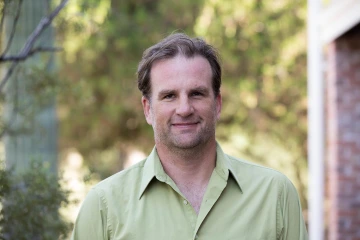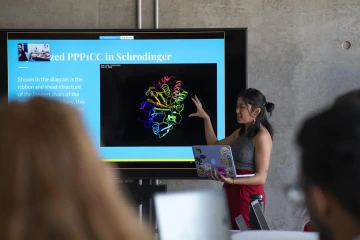New Health Sciences VIP Course Is a Meeting of Minds
What if a nursing student interested in improving quality of life for senior citizens could be put on a team with an engineering student and a computer science student? And what if instead of spending just 16 weeks getting their feet wet on the topic, they could help usher a project into existence semester after semester, watching it slowly unfold from start to finish?

Winslow Burleson, PhD, is bringing students across campus together in “transdisciplinary” teams advancing Health Sciences.
That’s the kind of experience Winslow Burleson, PhD, is offering all University of Arizona students with his new course, “Vertically Integrated Projects (VIP) in Health Sciences Design,” which is launching in the fall.
Vertically integrated projects (VIP) has grown into a nationwide consortium with 36 campuses, and the University of Arizona is ready to join that club — giving students mentorship opportunities in research, design, innovation and entrepreneurship.
Dr. Burleson says the term “vertically integrated” refers to the practice of bringing students at all levels together, from sophomores to doctoral candidates.
“The team of faculty, doctoral students and master’s students are mentors for undergraduates,” Dr. Burleson explained. “After the second or third year, juniors and seniors gain enough skill and in-depth experience that they run a lot of the undergraduate pieces themselves.”
Creating diverse teams
Students who enroll in VIP work on a single multidisciplinary project over the course of several semesters, re-enrolling for each term. Undergraduates can maintain involvement for up to three years, and graduate students can participate for the duration of their studies. The long-term nature of the course gives students ample opportunity to put a range of skills into practice, take on a variety of roles and make substantive contributions over time.

Students will enroll in VIP courses over multiple semesters, beginning as novices and gaining leadership and mentorship skills as they become more experienced.
“Vertically integrated projects work semester to semester,” Dr. Burleson said. “You have undergrads, graduate students and faculty all focused on a longitudinal project over several years to build a vertically integrated, coherent project to tackle real-world challenges.”
Those challenges are best met by bringing many minds to the table, with teams assembled from a range of departments across campus. By extending across the university, Dr. Burleson’s VIP course will teach Health Sciences students to work with people from a variety of professional backgrounds.
“As we design the next generation of smart homes, think about a smart dresser for someone living with dementia,” said Dr. Burleson, referring to the collaborations he’s advanced between nursing, engineering and computer science students. “When people living with dementia are getting dressed, they often get frustrated that somebody is in their room trying to help them. To address this, a smart dresser uses green lights on the front, motion sensors and personalized step-by-step instructions in a caregiver’s voice. The goal is to help maintain dignity, independence and quality of life.”
Just like other courses in design thinking, Dr. Burleson’s VIP series will empower students with tools to build self-reliance, allowing them to be more confident — and competent — when they enter the workforce. They will know how to work both independently and collaboratively to see a project through from start to finish. By exposing them to ideas outside their majors, Dr. Burleson said students’ “broad, collaborative teams” will help students break out of entrenched ways of thinking.
Catalyzing collaboration
Dr. Burleson has taken an exciting path to get to where he is today. His first job was for the SETI (Search for Extraterrestrial Intelligence) Institute, where he connected NASA scientists with K-12 students to engage learners in big questions, like calculating the probability of other lifeforms in the universe based on the number of stars or thinking about how to improve the design of the Mars lander to detect signs of life. Over the course of his career, he gained extensive experience in design thinking, which he previously taught at New York University before coming to the University of Arizona last year.
“I’ve been a transdisciplinary person throughout my life. When I got to NYU, I had to move from astronaut-robot mission simulators to nursing simulation,” Dr. Burleson said. “What I do is catalyze transdisciplinary teams. My work is furthering other people’s work.”
Undergraduate and graduate students will be brought together on the forthcoming UArizona Holodeck, an immersive, interactive learning environment on the third floor of the Health Sciences Library, where students can use virtual reality and other novel technologies to explore a wide range of research questions and engage in worldwide collaboration using virtual environments, telepresence and remote interaction. It is currently undergoing renovations with plans to open later this summer.

